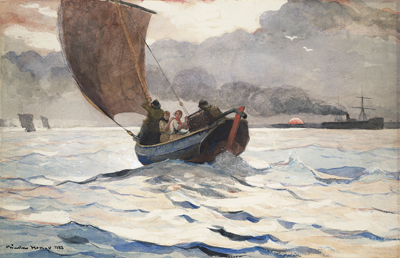Comparative Illustration: Returning Fishing Boats, 1883
Comparing the preparatory drawing Fishing Off Scarborough to the finished watercolor Returning Fishing Boats reveals that Homer replicated the central figure group and boat exactly. Such precise duplication would have only been possible with the use of a transfer process. Homer may have used commercially available graphite transfer paper or could have made his own by coating a sheet of paper with graphite. Then, positioning the drawing over the blank watercolor paper, he would have inserted the graphite-coated sheet between these two, with the graphite side facing the watercolor paper. Next, Homer traced the drawing, exerting significant pressure with a sharp pencil in order to transfer the design to the moderately textured watercolor paper. When finished, there was visible a faint copy that could be reinforced with graphite pencil prior to laying down the first washes. Microscopic examination of the watercolor reveals a preliminary graphite drawing and no other transferred media (such as black pigment from carbon paper). Slight position shifts in the sail and rigging between the two works can be attributed to an accidental shifting of the artist’s hand while tracing.
Returning Fishing Boats, 1883. Transparent watercolor, with opaque white watercolor, over graphite, on off-white wove paper; 409 x 635 mm (16 1/8 x 25 in.). Harvard University Art Museums, Fogg Art Museum, anonymous gift, 1939.233. Photo: Imaging Department © President and Fellows of Harvard College.

